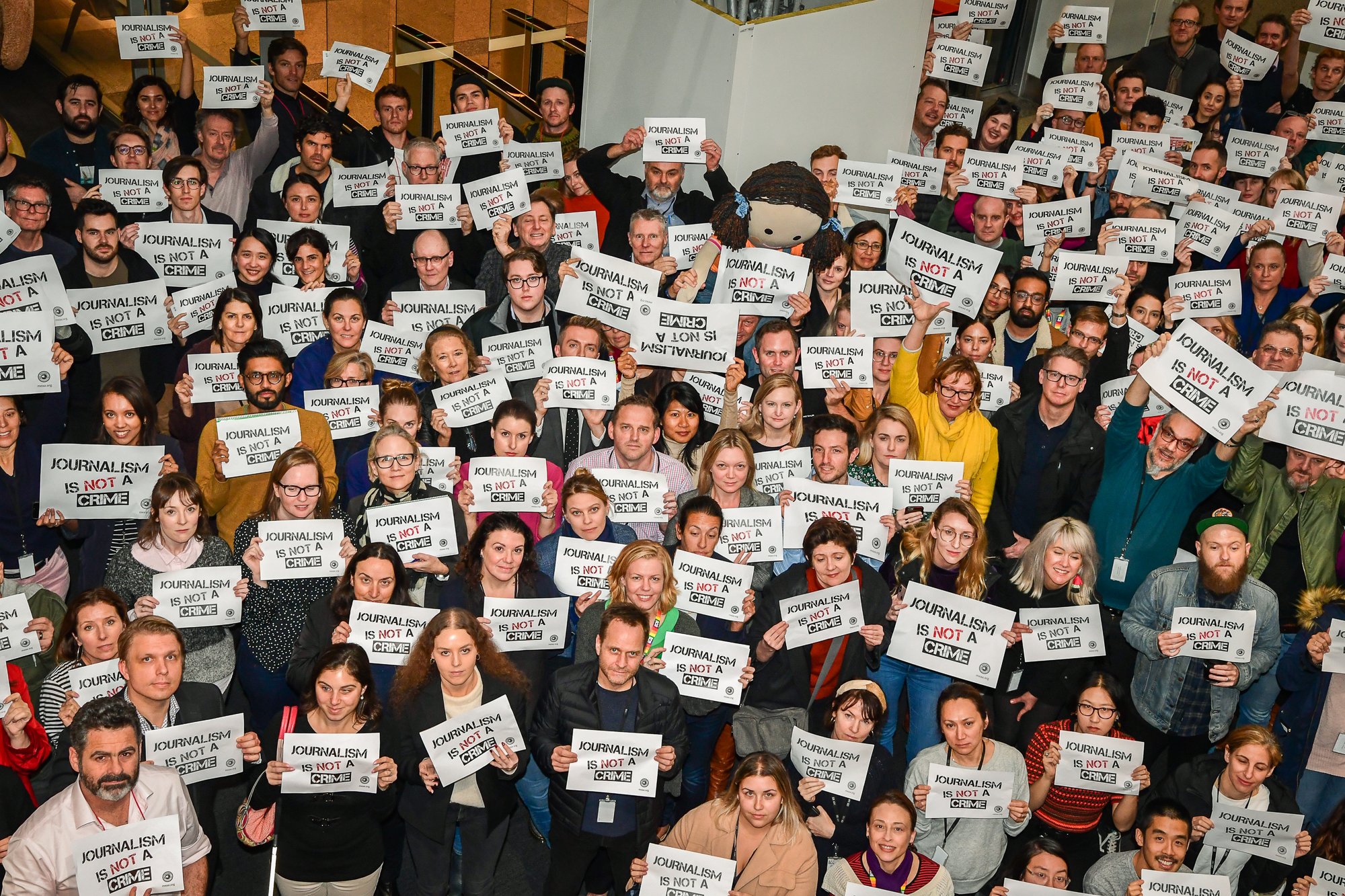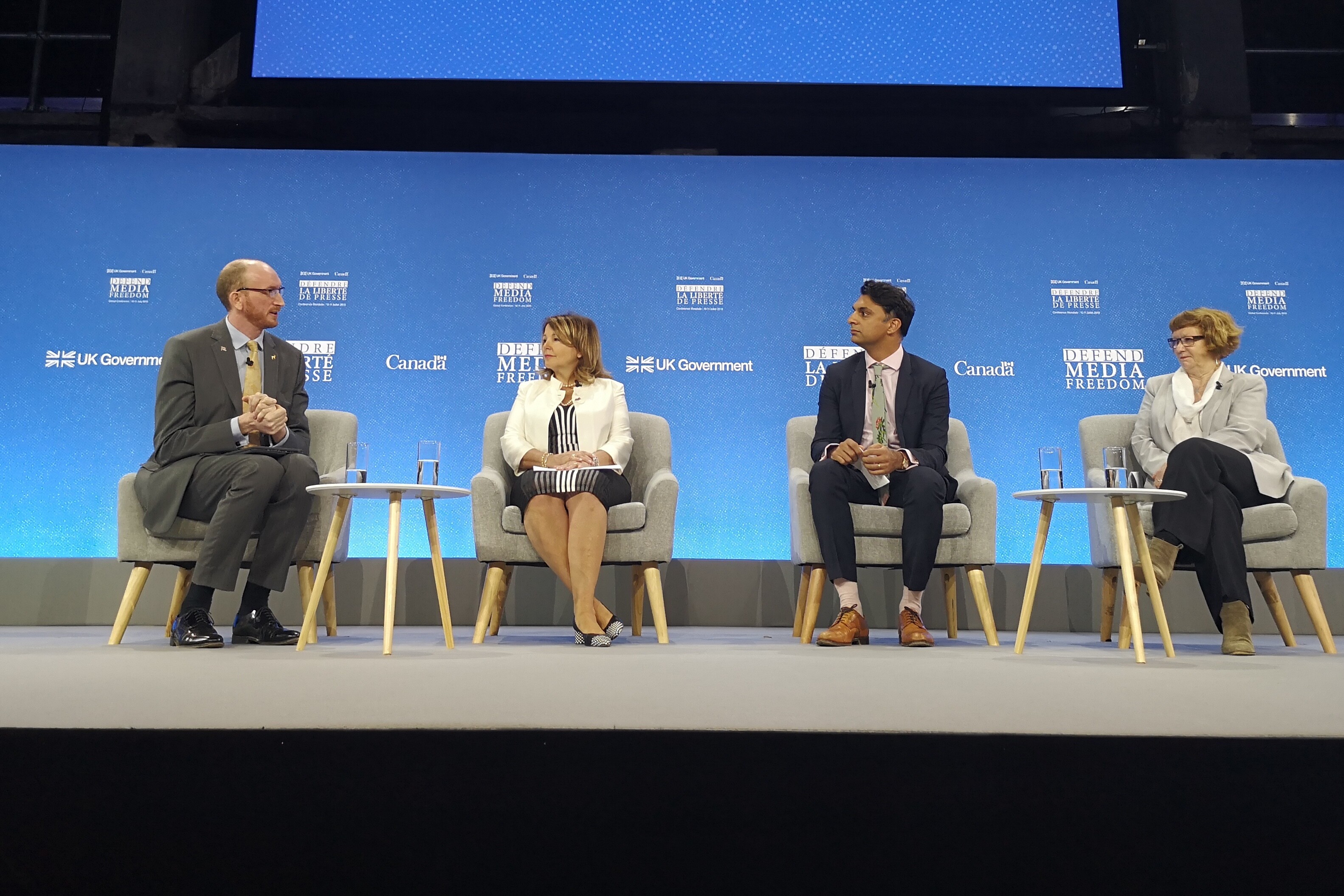By Dr Caitriona Noonan, Creative Industries Policy & Evidence Centre (PEC)
The number of journalists killed worldwide in retaliation for their news reporting nearly doubled in 2018 compared to the previous year, and yet independent journalism has never been more necessary for helping to sustain democratic governance around the globe. This was a key theme of this month’s Global Conference for Media Freedom, hosted by the UK and Canadian governments in London, to bring together international contributors in dialogue and debate.
In this blog, we report from the session on ‘Why Public Media Matters’, run by the Public Media Alliance (PMA), an international association for public broadcasters. This session gave a flavour of some of the discussions taking place within and about publicly funded media across the globe. Panelists included: Sally-Ann Wilson, CEO of Public Media Alliance, Cilla Benko, Director General and CEO of Swedish Radio, Giacomo Mazzone, Head of Institutional Relations at the EBU and Alan Sunderland, Former Editorial Director of ABC. Participants from around the world stressed the value of an independent publicly-funded media, the threats it faces in today’s commercial and political climate, and suggested interventions to ensure its sustainability.
The Value of Accountability and Trust
The value, and very real risk, of holding power to account was a recurring theme of the session. The panel reminded us that public media often lead on news reporting pursued in the public interest, and so can be the target of different forms of risk and intimidation. Alan Sunderland, former Editorial Director of the Australian public broadcaster ABC, warned that this is not always in the form of a direct threat of violence. He pointed to the experiences of his former organisation and the recent raids by police. Here the line between accountability and intimidation is finely drawn.
All the panellists reiterated that being accountable to the public is one of the key ways in which media organisations build trust. Sally-Ann Wilson, CEO of PMA, cautioned, ‘Trust is years in the making and minutes in the breaking’.
This is one of the reasons organisations like the BBC continue to invest in initiatives like The Blue Room – itself showcased in the main hall of the conference. The Blue Room is a technology lab which attempts to integrate and share the latest technologies with consumers, citizen groups and other media professionals.
Currently the lab is using AI technology to tackle the issue of disinformation and to counter the threat of co-ordinated deception activities within news provision. If public media are to ‘earn trust everyday’ (Sally-Ann Wilson), they need to put in place the editorial and technical processes to make that happen. One way to do this is through working in collaboration with external stakeholders, such as technology companies and the independent production sector.
Threats to Independent Publicly-funded Media
This session was also a call for a mixed ecology of media in which publicly funded media and commercial players inhabit the marketplace together. However, the panellists agreed this is also a moment in which the value of public media needs to be reiterated and communicated effectively – something outlined in the European Broadcasting Union’s Public Service Media values review which provides a framework for public media to assess their values and offers advice on advocacy efforts. As argued in other research, while large organisations, such as the BBC, often have dedicated resources to lobby for their role in the media ecology, smaller PSBs, with more limited means, often struggle to secure pertinent resources and so this kind of collaborative resources can deliver tangible value.
A key takeaway from the session was the twin threat to public media. One part of this relates to the business models needed to support the commissioning of original reporting, in-depth investigative journalism and niche content. New players are building economies of scale to secure their prominence within the market, actively competing for key resources, such as advertising revenue, copyright and talent. The familiar business models traditionally supporting public media are under threat.
A further, equally aggressive threat, comes in the form of an ideological shift in political support. Cilla Benko, Director General of Swedish Radio, noted that while every politician agrees with media freedom, often the rhetoric isn’t supported in practice, especially in the form of funding or legal protection.
Many of the panellists and audience members pointed to the risks from authoritarian regimes and populist narratives which conceive of media organisations, like public broadcasters, as ‘liberal elites’. Examples offered throughout the session pointed to government interferences across the globe, including in Hungary, Poland and Austria.
What next?
In this context, what can be done to improve the economic and cultural sustainability of publicly funded media? A very direct challenge was offered by the panel to countries like the UK and Canada to move from words to actions, and for policy-makers to put in place tangible measures to support publicly funded media.
This was partly summed up by Cilla Benko as a strategy of 4 Fs – finance, frameworks, friends and foes.
Finance: Long term and consistent funding allows public media to innovate and build capacity in new areas. Shrinking their funding and their mission doesn’t help them deliver on their public mission or to fully support the wider creative ecologies that they inhabit.
Frameworks: True independence should be guaranteed in the appropriate regulatory frameworks and legal structures.
Friends: It is essential that public media build a diverse constituency who can advocate for their value. However, as one audience member commented, public service media is a relatively new concept in parts of Africa and so novel ways are needed to engage audiences in buying into its values.
Foes: Public service media must continue to build conversations about their value, and for whom, including with those they may perceive as their enemies.
Much of this action-agenda means going beyond public media professionals and sympathetic politicians, and truly engaging with audiences, especially young people. How do you build deep engagement with young people who will become tomorrow’s licence fee holders and tax payers?
Suggestions were offered by those in the room, including engaging young people in content creation and decision-making, going to the spaces and platforms they use (such as social media) and building specialist provision such as young people’s news rooms. This is at the heart of PEC researcher Cindy Carter’s work on nurturing young people’s own sense of a democratic citizenship in which public media can play a vital role.
The session concluded with a call from Public Media Alliance for greater collaboration between and beyond publicly funded media and for this partnership to encompass content, technology and research. Research by the Creative Industries Policy and Evidence Centre is part of our response to that call and we look forward to sharing it with you in due course.
Dr Caitriona Noonan is a lecturer in Media and Communication in the School for Journalism, Media and Culture at Cardiff University. Her expertise lies in the areas of television production, public service broadcasting, creative labour and cultural policy. Her work appears in academic journals such as the International Journal of Cultural Policy, Cultural Trends, and the European Journal of Cultural Studies. Find out more…
This blog is written by the PEC team researching Arts, Culture and Public Service Broadcasting @CardiffJomec. All correspondence related to this can be directed to the blog’s lead author Dr Caitriona Noonan at noonanc@cardiff.ac.uk.
This blog was originally published by the Creative Industries Policy and Evidence Centre (PEC). Their mission is to provide independent research and authoritative recommendations that will aid the development of policies for the UK’s creative industries, contributing to their continued success.
Our thanks to Caitriona and PEC for allowing us to republish.

